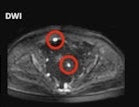Transcription–replication conflicts underlie sensitivity to PARP inhibitors
https://www.nature.com/articles/s41586-024-07217-2
It is interesting to note that treatment of disease may become commonplace without any real understanding of how it works. One such example is the use of PARP inhibitors for the treatment of ovarian cancer due to defective DNA repair, which includes about 80% of all ovarian cancer.
Previously, through a mechanism known as synthetic lethality, it was thought that PARPi worked by trapping the PARP enzyme on the chromosome and preventing its repair activity.
This basic research using yeast cells has demonstrated that the effect of PARPi is to alter proteins essential for DNA repair. These proteins have the memorable names of TIMELESS and TIPIN.
Understanding of the true reason for PARPi effectiveness will enable further drug development and also explain why, for about 20% of women with ovarian cancer, PARPi treatment is of no value.




.jpeg)





